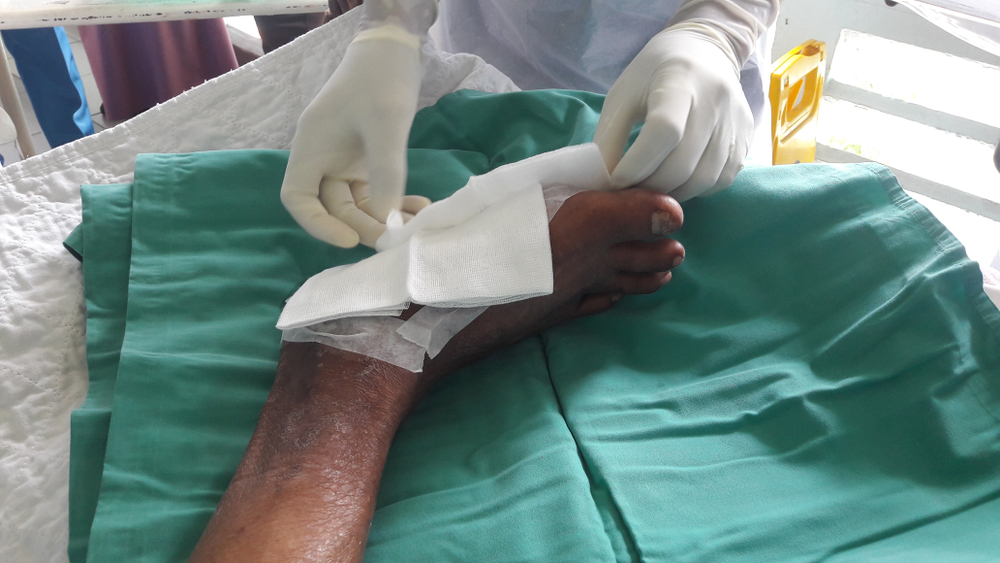Many patients with chronic wounds have injuries that are constantly exposed to damaging body secretions. These fluids cause extensive damage to the skin around a wound site resulting in slowed, sub-optimal healing. To prevent or limit moisture-related skin damage, wound care professionals must correctly recognize risk factors in susceptible individuals and treat established cases appropriately.
What is Moisture-Associated Skin Damage (MASD)?
Moisture-associated skin damage refers to the physically visible effects of inflammation due to various moisture sources. MASD can be triggered by many irritants including:
- Urine
- Sweat
- Stool
- Wound fluid
- Mucus
- Saliva
MASD often requires the input of other biological (microorganisms), chemical (acidic or alkaline wound environments), and mechanical (friction, trauma) factors to cause more extensive damage.
How Does MASD Occur?
For MASD to occur, an excess of damaging moisture and the presence of one or more suitable external factors (chemical, mechanical, biological agents) is required. An undamaged skin efficiently regulates its water content at all times preventing both excesses and deficiencies. In MASD, the loss of this tight regulatory control, and further exacerbation of wound injury by the application of friction, colonization by pathogenic microorganisms, or chemical excoriation results in extensive skin damage.
Types of MASD
There are four major types of moisture-associated skin damage including:
- Periwound moisture-associated dermatitis
- Peristomal moisture-associated dermatitis
- Incontinence moisture-associated dermatitis
- Intertriginous dermatitis
Periwound Moisture-Associated Dermatitis
Healing wounds typically produce some form of exudate during the inflammatory stage of tissue repair. In some cases, these secretions might become excessive leading to damage of unaffected skin around the wound site. The presence of proteins, bacteria, and digestive enzymes within wound exudate can cause skin damage up to 4 centimeter radius from the wound site. Periwound dermatitis can be further worsened by aggressive wound dressing techniques which weaken the integrity of skin surrounding the wound site.
Peristomal Moisture-Associated Dermatitis
In peristomal dermatitis, the injurious fluids originate from the wound site itself in addition to secretions from other body areas. Exposure to urine, stool, and sweat contributes to the structural damage observed in this form of MASD. A significant risk factor for the development of peristomal moisture-associated dermatitis is the lack of placement of an appropriate barrier around natural or surgically created stoma close to wound sites. With overwhelming exudate secretion, the skin around the wound site will undergo maceration and slough off.
Incontinence Moisture-Associated Dermatitis
This form of moisture-associated dermatitis is due to incontinence of urine and stool. Recurrent contact between these corrosive substances and the skin around a patient's wound will result in tissue maceration and breakdown.
Intertriginous Dermatitis
Intertriginous dermatitis occurs when sweat is trapped between skin folds. In these instances, poor circulation, and the prevention of evaporation causes skin damage and predisposes the affected area to bacterial colonization, and infection. This form of dermatitis is mostly associated with obesity due to affected individuals having more skin folds.
Clinical Picture in Moisture-Associated skin damage
The key signs and symptoms of moisture-associated skin damage are listed below.
- Erythema
- Moderate to severe pain
- Itching around the wound site
- Visible maceration (white/pale weakened skin)
- Viscous purulent exudate with crusting
- Skin erosion
Diagnosis of MASD
The diagnosis of the various forms of MASD is done clinically by physical examination of wound sites. Wound care specialists can also use any relevant patient history, and laboratory investigations to improve their diagnostic accuracy.
Treatment Strategies in MASD
The treatment goals in MASD are to remove any source of harmful moisture and boost wound healing. While general wound management protocols apply to all types of MASD, the treatment approaches will vary slightly between the different forms.
General Treatment Guidelines
Regardless of the type of MASD a patient develops, the following treatment strategies are crucial to the successful resolution of symptoms.
- Wound care with adequate debridement, dressing, and exudate control
- Pain management with appropriate analgesics (NSAIDs, opioid analgesics)
- Infection control with empirical and specific antibiotic therapy
Specific Treatment Strategies
There is a wide range of treatment strategies for managing MASD, depending on the causative factors/type of dermatitis:
Periwound Moisture-Associated Dermatitis:
- Wound surveillance for skin changes
- Use of highly absorptive wound dressings to control exudate
- Application of protective barriers/film around the wound site
Peristomal Moisture-Associated Dermatitis:
- Maintenance of protective pouch around stomal sites to prevent fluid leakage
- Use of appropriately sized skin barriers, protective rings, and skin pastes.
Incontinence-Associated Dermatitis:
- Routine skin cleansing, debridement, and moisturizing
- Consistent use of skin protectants
Intertriginous Dermatitis:
- Moisture control with appropriate protective skin barriers and wound dressings
- Maintenance of proper skin hygiene
- Dietary modification with weight control
- Use of non-constrictive, highly absorbent clothes
Barrier Products Used in Moisture-Associated Damage
Various barrier preparations can be used to limit the effect of moisture on wound sites including:
- Petrolatum-based barrier ointments
- Zinc-oxide creams
- Silicone-based preparations
- Polymer films
Petrolatum-based preparations offer hydrophobic protection when applied around wound sites however they reduce the adhesiveness of applied wound dressings. Zinc oxide creams provide similar protection with effective barrier function when applied to the skin around the wound site in sufficient quantities.
Silicone-based preparations are particularly useful in managing periwound moisture-associated dermatitis. In addition to protection against moisture-related damage, silicone-based creams also supply antioxidants, and crucial nutrients required for optimal wound healing. Polymer films are optimized for the prevention of maceration in at-risk skin areas however they are associated with a risk of allergic reactions.



.webp)

.avif)